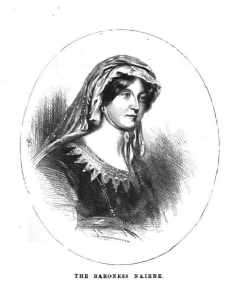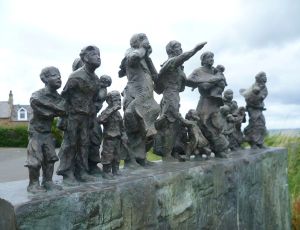Carolina Oliphant (Lady Nairne)
Keeley W.
Carolina Oliphant also known as Lady Nairne was born into an aristocratic family at the” ‘Auld Hoose’ of Gask, Perthshire, on August 16th, 1766″( Donaldson, Oxford Database). Carolina Oliphant was the daughter of Laird Laurence Olipant who with Prince Charles fought during the Jacobite uprisings, and Margret Struan. Oliphant was a famous songstress who would continually veil her identity and sign her works with B.B. when they were being published like many other Scottish women writing at the time.
On June 6th 1806, Carolina Oliphant married her second cousin Major William Murray Nairne at her family home in Gask in Perthshire. Marrying a second cousin was very common in these days especially in aristocratic families to keep the blood lines as ‘pure’ as possible. After getting married, Lady Nairne and her husband William settled in Duddingston near Edinburgh where they lived in Caroline Cottage. This particular cottage that Lady Nairne and her husband were living in was built and helped funded for by her uncle Chief of Strowan a notable Jacobite who she composed and copied many Jacobite songs for (Donaldson).
In 1808 Lady Nairne gave birth to her one and only child William Murray Nairne. William faced many different medical conditions and was very sickly throughout his whole life and was taken care by his mother during his short life. Not much is known about Lady Nairne’s son except for the fact that he was sick almost all the time. There isn’t anywhere in particular that names the type of ailments that young William faced in his life.
In 1821 Lady Nairne’s close friend Misses Hume meets Mr. Robert Purdie a music publisher at a party. Purdie tries to convince Lady Nairne through her friend Misses Hume to write for the Scottish Minstrel (Brown, Orlando Database). Lady Nairne agrees to write for the Scottish Minstrel under the name of “Mrs. Bogan of Bogan” or “B.B.”. Even though Lady Nairne agreed to write for the Minstrel under a different name she still veiled herself from Robert Purdie and only ever met him twice in person and when she did she went in disguise so he wouldn’t know what she looked like. In 1824 the Scottish Minstrel is completed in six octavo volumes
On July 9th 1830 Lady Nairne’s husband William dies at the family home (Donaldson). After this tragedy Lady Nairne decided to take her son and leave the home that her husband had died in and relocate from Duddingston to Kingstown, Ireland. In the same year Caroline Oliphant, Lady Nairne’s niece passes away after being very sickly her whole life. Lady Nairne did not know her niece extremely well but Caroline was also interested in writing and produced poetry and songs like her aunt (Brown). Caroline also has some of her writings in the book, Life and Songs of the Baroness Nairne. With a memoir and poems of Caroline Oliphant theYounger.
The Garden at Gask – Caroline Oliphant
Fain would I linger here, as I have seen
The sun reposing on this mossy green,
That well might tempt his chariot-wheels to stay,
And check his coursers in their fiery way.
Speed on, thou Sun, thy home is in the west;
I too must speed, for this is not my rest.
Like thee, bright orb! my further path is traced,
And to my going down I too must haste;
For on my pilgrim path no Gibeon’s hill
Invites my weary spirit to stand still.
Thou hast returned and brought the shadow back;
I may not, would not, turn me from my track.
Still o’er these mossy walks thy circuit make,
Still in these bowers thy bright siesta take;
On me the gate hath closed, and I must go
Forth from this Eden thro’ a vale of woe;
Diverse our path, yet both our God hath blest;
Heav’n spreads a couch for each — a glorious golden rest.
(Nairne, 274)
It is obvious looking at the structure of the poem that Caroline did adopt the same style as her aunt. The poem is in ballad form and is also talking about familiar territory, a garden in Gask. Even though Caroline Oliphant died at a very young age, her poems show that women of their family kept the ballad a tradition in the family.
After living in Kingstown Ireland for three years Lady Nairne and her son William decided to pack up and travel all over Europe to places such as Italy, France, and Switzerland (Donaldson). Unfortunately after extensive traveling Lady Narine’s son William dies on December 7th 1837 in Brussels. Now having no immediate family in her life Lady Nairne continues to travel and doesn’t resurface until a couple years later. This lapse of period in Lady Nairne’s timeline can suggest that possibly all she wanted to do was hide and mourn her late husband and son and contemplate what her purpose now was because she had no one to take care of.
In the years from 1840 to 1844 there were many disputes being made over the authorship of the songs produced my Mrs. Bogan of Bogan. Lady Nairne was particularly upset that the infamous Robbie Burns was getting credit for some of her poems and writes about it to one of her close friends (Nairne, Life and Songs of the Baroness Nairne). It is interesting however that Lady Nairne was so offended that Robbie Burns was getting credit for her work because throughout her entire life all she did was veil who she was as a writer. Lady Nairne could have easily put a stop to the disputes of her authorship if she simply came forward and let everyone know that she was the infamous songstress known as “B.B.”.
In April 1843, growing old with age, Lady Nairne moves back to Gask in Perthshire to be with the remaining family that she has left. Nairne enjoys two years full of love and family in Gask and then dies on October 26th 1845 at the family home where Lady Nairne was buried in the family chapel.
“Lady Nairne lived to do good, avoided publicity and sought the shade. From the scene of life she desired to pass away silently, there to be remembered only by her friends and relatives. When she died her powers as an authoress were known only to a few.” ( Life and Songs of the Baroness Nairne, 134).
After her death Lady Nairne’s words still moved many people. In 1881 there was a great European windstorm that took away many lives. There is a monument that is dedicated to the many people that either died or had lost loved ones at the Eyemouth disaster. A quote by Lady Naire is with the statue.
“Wha’ll buy my fresh herrin’? They’re no’ brought here without brave darin’, Buy my caller herrin’, Haul’d through wind and rain.
Buy my caller herrin’! Though ye may ca’ them vulgar farin’. Wives and mithers, maist despairin’, Ca’ them lives o’ men.” — Lady Nairne
Works Cited
Brown, Susan, Patricia Clements, and Isobel Grundy, eds. Carolina Oliphant, Lady
Nairne entry: Writing screen within Orlando: Women’s Writing in the British Isles from the
Beginnings to the Present. Cambridge: Cambridge University Press Online, 2006. 17 January 2013.
Nairne, Carolina Oliphant, Lady (as the Baroness Nairne). Life and Songs of the Baroness Nairne. With a memoir and poems
of Caroline Oliphant the Younger. Charles Rogers ed., and Caroline Oliphant. (1869).
Edinburgh: J. Grant, 1896.
William Donaldson, ‘Oliphant, Carolina, Lady Nairne (1766–1845)’, Oxford Dictionary of
National Biography, Oxford University Press, 2004 [http://www.oxforddnb.com.ezproxy.library.uvic.ca/view/article/19723, accessed 17 Jan 2013]
Further Resources



